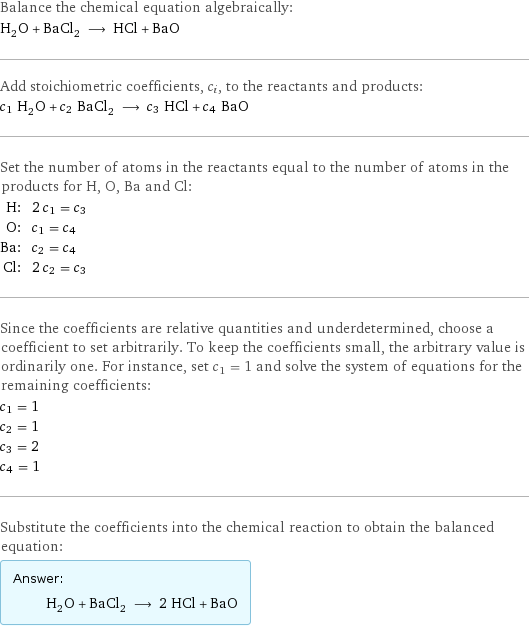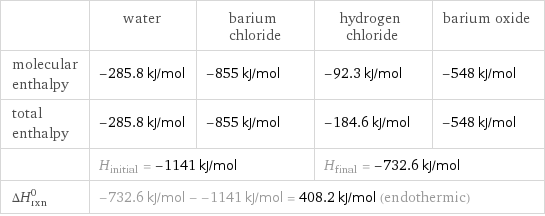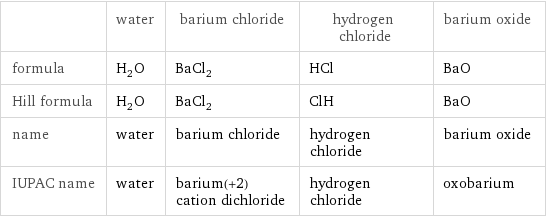Input interpretation

H_2O (water) + BaCl_2 (barium chloride) ⟶ HCl (hydrogen chloride) + BaO (barium oxide)
Balanced equation

Balance the chemical equation algebraically: H_2O + BaCl_2 ⟶ HCl + BaO Add stoichiometric coefficients, c_i, to the reactants and products: c_1 H_2O + c_2 BaCl_2 ⟶ c_3 HCl + c_4 BaO Set the number of atoms in the reactants equal to the number of atoms in the products for H, O, Ba and Cl: H: | 2 c_1 = c_3 O: | c_1 = c_4 Ba: | c_2 = c_4 Cl: | 2 c_2 = c_3 Since the coefficients are relative quantities and underdetermined, choose a coefficient to set arbitrarily. To keep the coefficients small, the arbitrary value is ordinarily one. For instance, set c_1 = 1 and solve the system of equations for the remaining coefficients: c_1 = 1 c_2 = 1 c_3 = 2 c_4 = 1 Substitute the coefficients into the chemical reaction to obtain the balanced equation: Answer: | | H_2O + BaCl_2 ⟶ 2 HCl + BaO
Structures

+ ⟶ +
Names

water + barium chloride ⟶ hydrogen chloride + barium oxide
Reaction thermodynamics
Enthalpy

| water | barium chloride | hydrogen chloride | barium oxide molecular enthalpy | -285.8 kJ/mol | -855 kJ/mol | -92.3 kJ/mol | -548 kJ/mol total enthalpy | -285.8 kJ/mol | -855 kJ/mol | -184.6 kJ/mol | -548 kJ/mol | H_initial = -1141 kJ/mol | | H_final = -732.6 kJ/mol | ΔH_rxn^0 | -732.6 kJ/mol - -1141 kJ/mol = 408.2 kJ/mol (endothermic) | | |
Gibbs free energy

| water | barium chloride | hydrogen chloride | barium oxide molecular free energy | -237.1 kJ/mol | -806.7 kJ/mol | -95.3 kJ/mol | -520.3 kJ/mol total free energy | -237.1 kJ/mol | -806.7 kJ/mol | -190.6 kJ/mol | -520.3 kJ/mol | G_initial = -1044 kJ/mol | | G_final = -710.9 kJ/mol | ΔG_rxn^0 | -710.9 kJ/mol - -1044 kJ/mol = 332.9 kJ/mol (endergonic) | | |
Equilibrium constant
![Construct the equilibrium constant, K, expression for: H_2O + BaCl_2 ⟶ HCl + BaO Plan: • Balance the chemical equation. • Determine the stoichiometric numbers. • Assemble the activity expression for each chemical species. • Use the activity expressions to build the equilibrium constant expression. Write the balanced chemical equation: H_2O + BaCl_2 ⟶ 2 HCl + BaO Assign stoichiometric numbers, ν_i, using the stoichiometric coefficients, c_i, from the balanced chemical equation in the following manner: ν_i = -c_i for reactants and ν_i = c_i for products: chemical species | c_i | ν_i H_2O | 1 | -1 BaCl_2 | 1 | -1 HCl | 2 | 2 BaO | 1 | 1 Assemble the activity expressions accounting for the state of matter and ν_i: chemical species | c_i | ν_i | activity expression H_2O | 1 | -1 | ([H2O])^(-1) BaCl_2 | 1 | -1 | ([BaCl2])^(-1) HCl | 2 | 2 | ([HCl])^2 BaO | 1 | 1 | [BaO] The equilibrium constant symbol in the concentration basis is: K_c Mulitply the activity expressions to arrive at the K_c expression: Answer: | | K_c = ([H2O])^(-1) ([BaCl2])^(-1) ([HCl])^2 [BaO] = (([HCl])^2 [BaO])/([H2O] [BaCl2])](../image_source/dcc3be85ef39c075fa1bb50938d133de.png)
Construct the equilibrium constant, K, expression for: H_2O + BaCl_2 ⟶ HCl + BaO Plan: • Balance the chemical equation. • Determine the stoichiometric numbers. • Assemble the activity expression for each chemical species. • Use the activity expressions to build the equilibrium constant expression. Write the balanced chemical equation: H_2O + BaCl_2 ⟶ 2 HCl + BaO Assign stoichiometric numbers, ν_i, using the stoichiometric coefficients, c_i, from the balanced chemical equation in the following manner: ν_i = -c_i for reactants and ν_i = c_i for products: chemical species | c_i | ν_i H_2O | 1 | -1 BaCl_2 | 1 | -1 HCl | 2 | 2 BaO | 1 | 1 Assemble the activity expressions accounting for the state of matter and ν_i: chemical species | c_i | ν_i | activity expression H_2O | 1 | -1 | ([H2O])^(-1) BaCl_2 | 1 | -1 | ([BaCl2])^(-1) HCl | 2 | 2 | ([HCl])^2 BaO | 1 | 1 | [BaO] The equilibrium constant symbol in the concentration basis is: K_c Mulitply the activity expressions to arrive at the K_c expression: Answer: | | K_c = ([H2O])^(-1) ([BaCl2])^(-1) ([HCl])^2 [BaO] = (([HCl])^2 [BaO])/([H2O] [BaCl2])
Rate of reaction
![Construct the rate of reaction expression for: H_2O + BaCl_2 ⟶ HCl + BaO Plan: • Balance the chemical equation. • Determine the stoichiometric numbers. • Assemble the rate term for each chemical species. • Write the rate of reaction expression. Write the balanced chemical equation: H_2O + BaCl_2 ⟶ 2 HCl + BaO Assign stoichiometric numbers, ν_i, using the stoichiometric coefficients, c_i, from the balanced chemical equation in the following manner: ν_i = -c_i for reactants and ν_i = c_i for products: chemical species | c_i | ν_i H_2O | 1 | -1 BaCl_2 | 1 | -1 HCl | 2 | 2 BaO | 1 | 1 The rate term for each chemical species, B_i, is 1/ν_i(Δ[B_i])/(Δt) where [B_i] is the amount concentration and t is time: chemical species | c_i | ν_i | rate term H_2O | 1 | -1 | -(Δ[H2O])/(Δt) BaCl_2 | 1 | -1 | -(Δ[BaCl2])/(Δt) HCl | 2 | 2 | 1/2 (Δ[HCl])/(Δt) BaO | 1 | 1 | (Δ[BaO])/(Δt) (for infinitesimal rate of change, replace Δ with d) Set the rate terms equal to each other to arrive at the rate expression: Answer: | | rate = -(Δ[H2O])/(Δt) = -(Δ[BaCl2])/(Δt) = 1/2 (Δ[HCl])/(Δt) = (Δ[BaO])/(Δt) (assuming constant volume and no accumulation of intermediates or side products)](../image_source/73ddc0d4a431c1a582722e319de4c07c.png)
Construct the rate of reaction expression for: H_2O + BaCl_2 ⟶ HCl + BaO Plan: • Balance the chemical equation. • Determine the stoichiometric numbers. • Assemble the rate term for each chemical species. • Write the rate of reaction expression. Write the balanced chemical equation: H_2O + BaCl_2 ⟶ 2 HCl + BaO Assign stoichiometric numbers, ν_i, using the stoichiometric coefficients, c_i, from the balanced chemical equation in the following manner: ν_i = -c_i for reactants and ν_i = c_i for products: chemical species | c_i | ν_i H_2O | 1 | -1 BaCl_2 | 1 | -1 HCl | 2 | 2 BaO | 1 | 1 The rate term for each chemical species, B_i, is 1/ν_i(Δ[B_i])/(Δt) where [B_i] is the amount concentration and t is time: chemical species | c_i | ν_i | rate term H_2O | 1 | -1 | -(Δ[H2O])/(Δt) BaCl_2 | 1 | -1 | -(Δ[BaCl2])/(Δt) HCl | 2 | 2 | 1/2 (Δ[HCl])/(Δt) BaO | 1 | 1 | (Δ[BaO])/(Δt) (for infinitesimal rate of change, replace Δ with d) Set the rate terms equal to each other to arrive at the rate expression: Answer: | | rate = -(Δ[H2O])/(Δt) = -(Δ[BaCl2])/(Δt) = 1/2 (Δ[HCl])/(Δt) = (Δ[BaO])/(Δt) (assuming constant volume and no accumulation of intermediates or side products)
Chemical names and formulas

| water | barium chloride | hydrogen chloride | barium oxide formula | H_2O | BaCl_2 | HCl | BaO Hill formula | H_2O | BaCl_2 | ClH | BaO name | water | barium chloride | hydrogen chloride | barium oxide IUPAC name | water | barium(+2) cation dichloride | hydrogen chloride | oxobarium